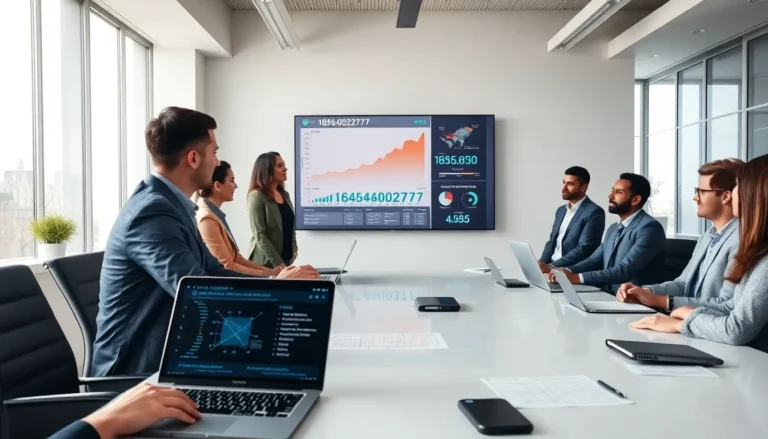In the world of education, student feedback reports are like the secret sauce that can transform a bland dish into a gourmet meal. They offer valuable insights that can boost teaching effectiveness and enhance the learning experience. But let’s face it—reading a feedback report can sometimes feel like deciphering hieroglyphics.
Table of Contents
ToggleOverview of Student Feedback Report
Student feedback reports serve as essential tools for educational institutions. These reports compile insights from students regarding their learning experiences, teaching methods, and course content. By analyzing this feedback, educators can enhance pedagogical approaches and better address student needs.
Key sections in a typical student feedback report include quantitative data, trends, and qualitative remarks. Quantitative data typically reflects student satisfaction levels, often gathered through Likert scale questions. Trends can identify consistent patterns in student responses, highlighting areas that require immediate attention.
Qualitative remarks provide depth to the numerical data, offering context and specific examples that illustrate student perspectives. Stakeholders can utilize these insights to foster improvements in curriculum design and teaching strategies.
Timely distribution of feedback reports plays a critical role in their effectiveness. Educators can apply findings from recent feedback during subsequent courses, ensuring that student voices influence real change. Collaborating with administration improves the capacity for targeted interventions based on feedback trends.
Regular assessments of student feedback reports allow institutions to track improvements over time. Comparing reports from different semesters or academic years sheds light on the effectiveness of implemented changes. Data visualization tools can further enhance the clarity of findings for better comprehension.
Incorporating student feedback into decision-making processes ensures that teaching methods remain aligned with student expectations. Overall, student feedback reports act as guiding frameworks, driving continuous enhancement in educational practices and student engagement.
Importance of Student Feedback
Student feedback reports serve as vital instruments in enhancing the educational landscape. They provide measurable insights into learning experiences that directly affect student outcomes.
Enhancing Learning Outcomes
Collecting student feedback can boost student performance. Feedback identifies areas where students struggle, enabling targeted interventions. Reports reveal trends in comprehension and engagement, offering valuable data for educators. Insights gathered can lead to curriculum adjustments that address specific challenges. Educators can implement changes promptly, reflecting on the needs of their students. Continuous evaluation guarantees that teaching methods are effective in promoting learning.
Informing Teaching Strategies
Effective teaching strategies stem from understanding student perspectives. Feedback highlights the impact of instructional methods on student engagement. Educators can adapt their approaches based on qualitative responses that illustrate students’ feelings about the material. Reports guide instructors to explore innovative techniques and resources, broadening traditional teaching methods. Collaboration between students and educators fosters an environment of mutual growth. Adapting to feedback ensures teaching remains relevant and responsive to student needs.
Components of a Student Feedback Report
A well-structured student feedback report includes several key components that enhance its effectiveness. Each section serves a distinct purpose, providing valuable insights.
Survey Design and Question Types
Effective survey design begins with clear objectives. Questions should relate directly to student experiences and perceptions. Close-ended questions provide quantifiable data, while open-ended questions offer qualitative insights. Likert scales help gauge satisfaction levels, enabling easy comparison of responses. Including demographic questions can identify trends across different student groups. Ensuring questions remain unbiased encourages honest feedback from students. This careful design maximizes the reliability of the data collected.
Data Analysis Techniques
Analyzing data from feedback reports involves both quantitative and qualitative methods. Descriptive statistics reveal overall satisfaction trends and highlight areas needing improvement. Cross-tabulation analyzes relationships between different variables, offering deeper insights. Thematic analysis of open-ended responses identifies common themes and concerns among students. Utilizing visualization tools, like charts and graphs, makes data interpretation easier. High-quality analysis informs actionable recommendations for educators and administrators, ultimately enhancing the learning environment. Consistent evaluation of feedback strengthens future surveys and fosters ongoing improvement.
Best Practices for Implementing Feedback Reports
Implementing feedback reports effectively requires strategic approaches to ensure students provide clear insights. Fostering an environment that encourages honesty is crucial for gathering valuable data.
Encouraging Honest Responses
Creating a safe space for students to share their opinions leads to more authentic feedback. Assuring anonymity helps students feel comfortable expressing valid concerns or suggestions. Interactive workshops or focus groups can further facilitate open dialogue, allowing students to share experiences in a supportive setting. Communication about the purpose of feedback ensures students understand how their inputs directly contribute to improvement. Regular reminders that feedback is valued reinforces its importance, motivating students to participate actively in the survey process.
Utilizing Feedback for Improvement
Using feedback effectively demands prompt action to address concerns raised by students. Identifying common themes within feedback reports enables educators to prioritize areas needing attention. Collaborating with faculty and administration fosters collective ownership of the improvement process. Adopting a systematic approach to analyze quantitative and qualitative data informs targeted strategies that enhance student experiences. Communicating results back to students shows appreciation for their input, encouraging ongoing participation. Regular revisions to teaching methods based on student feedback ensure continuous enhancement of educational practices.
Common Challenges and Solutions
Student feedback reports encounter various challenges, particularly in fostering effective communication and trust between students and educators. Addressing these challenges directly improves feedback quality.
Addressing Resistance to Feedback
Resistance can arise when students hesitate to provide feedback. Encouraging participation starts with educators showcasing how feedback influences teaching methods. Engaging students in conversations about their learning experiences promotes a culture of openness. Involving students in developing feedback mechanisms enhances their investment in the process. Highlighting success stories where feedback led to positive changes can motivate students to contribute. Demonstrating the tangible benefits encourages students to share their thoughts without fear of reprisal.
Ensuring Anonymity and Trust
Ensuring anonymity is crucial for gathering honest feedback. Educators must communicate that responses remain confidential, fostering a safe environment. Trust builds when students feel secure sharing their opinions. Providing clear guidelines on how data is handled can mitigate concerns. Implementing anonymous surveys supports candid responses and encourages participation. Regularly revisiting this commitment reinforces students’ confidence in the process. Maintaining transparency during feedback collection and analysis builds credibility and strengthens relationships between students and faculty.
Conclusion
Student feedback reports are indispensable tools that drive educational improvement. By harnessing student insights, educators can tailor their approaches to better meet learner needs. The data collected not only highlights areas for enhancement but also fosters a collaborative environment that encourages growth.
Timely and effective use of these reports can lead to significant advancements in teaching methods and student engagement. When institutions prioritize transparency and communication, they cultivate trust and encourage honest feedback. This ongoing dialogue between students and educators ultimately shapes a more responsive and effective learning environment, ensuring that educational practices evolve alongside student expectations. Embracing student feedback is key to unlocking the full potential of the educational experience.





